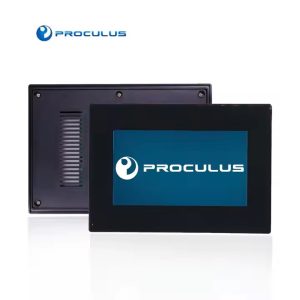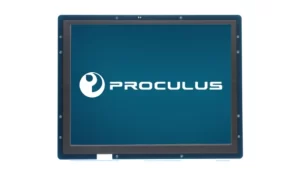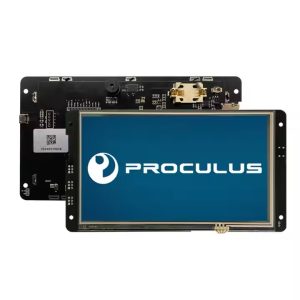TFT vs LCD: what they are, differences and which one to choose
When selecting display technology for embedded systems and electronic devices, understanding the differences between TFT LCD and standard LCD options is crucial for making informed decisions.
When comparing TFT vs LCD displays, the differences might seem subtle at first but they can drastically impact the performance, cost, and user experience of your product.
One offers vibrant colors and fast response times, while the other excels in simplicity and power efficiency. But which one is truly right for your project?
Before you choose, it’s essential to understand how these technologies work, where they shine, and where they fall short.
Let’s break it all down so you can make the smartest decision for your design. Keep reading!
 While all TFT displays are technically LCDs, the key difference lies in how the pixels are controlled.
Standard LCDs typically use a passive matrix system, where the control of pixels is slower and less precise.
TFT displays, on the other hand, use an active matrix of thin-film transistors, allowing each pixel to be individually addressed more quickly and accurately.
This distinction impacts several factors, like:
While all TFT displays are technically LCDs, the key difference lies in how the pixels are controlled.
Standard LCDs typically use a passive matrix system, where the control of pixels is slower and less precise.
TFT displays, on the other hand, use an active matrix of thin-film transistors, allowing each pixel to be individually addressed more quickly and accurately.
This distinction impacts several factors, like:
What is TFT Display?
A TFT (Thin-Film Transistor) display is a type of active matrix LCD, where each pixel is individually controlled by one to four transistors. This technology dramatically improves image stability, sharpness, and refresh rate compared to traditional passive matrix displays. TFT screens are commonly used in devices requiring vibrant graphics and responsive interfaces, such as industrial control panels, medical equipment, automotive dashboards, and consumer electronics. They are also widely compatible with capacitive and resistive touch technology, enhancing usability in both high-end and cost-sensitive applications.Pros and cons of TFT Display
Here are the pros and cons of a TFT Display:Pros
- Superior Image Quality: Superior resolution and color accuracy due to active pixel control.
- Fast Response Time: Ideal for animations, touch feedback, or rapid data updates.
- Wide Compatibility: Works well with various embedded systems and microcontrollers.
- Touch-ready: Easily integrates with touchscreens for interactive applications.
Cons
- Higher Power Consumption: Compared to passive LCDs, TFTs consume more energy, especially at higher brightness levels.
- Limited Viewing Angles (in basic models): Unless using IPS (In-Plane Switching) technology, viewing clarity can drop off at angles.
- Cost: Slightly more expensive than standard LCDs, though prices have dropped significantly in recent years.
What is LCD Display?
Standard LCD technology typically refers to passive matrix displays, including segment displays and simple dot-matrix configurations. These displays use a grid of electrodes to control liquid crystal alignment without individual transistor switching for each pixel. These crystals modulate light when voltage is applied, creating visible images. Standard LCDs use a passive matrix, where pixel control is slower and shared among lines, resulting in reduced contrast and refresh speed compared to active matrix (TFT) displays. LCDs are a solid choice for applications that prioritize low power consumption and basic visual output—like digital clocks, calculators, thermostats, or status panels. Their simple construction makes them cost-effective and suitable for devices that don’t require complex GUI elementsPros and cons of LCD Display
And here are the pros and cons of LCD displays:Pros
- Low Power Usage: Ideal for battery-powered or always-on devices.
- Affordable: Cost-effective for projects with basic display needs.
- Reliable: Long operational life and stable performance in low-demand environments.
Cons
- Limited Color and Resolution: Not suitable for applications requiring rich graphics or animations.
- Slower Response Time: Less ideal for real-time feedback or dynamic content.
- Narrow Viewing Angles: Images may appear faded or distorted when not viewed head-on.
TFT vs LCD: what are the differences?
 While all TFT displays are technically LCDs, the key difference lies in how the pixels are controlled.
Standard LCDs typically use a passive matrix system, where the control of pixels is slower and less precise.
TFT displays, on the other hand, use an active matrix of thin-film transistors, allowing each pixel to be individually addressed more quickly and accurately.
This distinction impacts several factors, like:
While all TFT displays are technically LCDs, the key difference lies in how the pixels are controlled.
Standard LCDs typically use a passive matrix system, where the control of pixels is slower and less precise.
TFT displays, on the other hand, use an active matrix of thin-film transistors, allowing each pixel to be individually addressed more quickly and accurately.
This distinction impacts several factors, like:
- Image Quality: TFT LCD displays provide superior image quality through active pixel control, delivering higher contrast ratios, better color reproduction, and sharper image rendering. Standard LCDs offer adequate quality for basic text and simple graphics but cannot match the visual performance of TFT technology.
- Response Time: Response times differ significantly between technologies. TFT displays typically achieve response times under 25 milliseconds, while standard LCDs may require 100-300 milliseconds for pixel transitions, making them unsuitable for dynamic content.
- Power Consumption: Standard LCDs generally consume less power, particularly in reflective configurations that eliminate backlighting requirements. However, modern TFT displays with LED backlighting and power management features have significantly reduced this gap.
- Cost: Standard LCD displays typically offer lower initial costs due to simpler manufacturing requirements and fewer electronic components. As TFTs become more mainstream, the price difference is decreasing.
TFT vs LCD: when to use each one?
Choosing between TFT and standard LCD depends largely on your application’s specific requirements:- Use LCD when:
- Your project prioritizes cost-efficiency over display performance.
- Power consumption is a critical constraint (e.g., battery-powered devices).
- Simple UI elements (e.g., static text or basic icons) are sufficient.
- The display will be viewed primarily head-on and under consistent lighting.
- Use TFT when:
- You need high-resolution graphics or dynamic user interfaces.
- Touch interaction or real-time data visualization is part of the design.
- You expect varied viewing angles or exposure to different lighting conditions.
- You’re developing for industrial, medical, or consumer applications where display clarity and responsiveness are crucial.
TFT vs LCD: which one to choose for your project?
The best choice ultimately depends on the balance between functionality, performance, and budget:- If your project calls for modern interfaces, touch capabilities, and quick development cycles, TFT displays — especially those with UART interfaces—offer a robust and scalable solution.
- If you’re working on a low-cost or ultra-low-power device, and the visual demands are minimal, a basic LCD might suffice.
How Proculus Technologies Can Help
When it comes to developing intuitive, responsive, and professional-grade human-machine interfaces (HMIs), Proculus Technologies offers a powerful solution with its UART TFT LCD modules. These modules simplify GUI development by offloading the graphical processing from your main MCU, allowing you to create rich user experiences without writing complex graphic code. With the support of UnicView Studio — Proculus’s drag-and-drop design software — you can build and deploy modern interfaces in a fraction of the time, all while maintaining performance and visual quality. Whether you’re designing for industrial control systems, smart appliances, medical equipment, or consumer electronics, Proculus modules provide the ideal blend of flexibility, functionality, and ease of integration. By choosing Proculus, you’re not just buying a display—you’re investing in a smarter development process and a superior end-user experience. Explore the full potential of UART TFT LCD modules and accelerate your product development today with Proculus. Click here to learn more!Conclusion
Choosing between TFT and standard LCD technology depends on your project’s specific requirements, but one thing is clear: when performance, user experience, and speed of development matter, TFT is often the better path forward. And with Proculus Technologies, implementing a high-quality TFT display becomes faster, easier, and more cost-effective than ever. Whether you’re building your first prototype or scaling to mass production, Proculus gives you the tools and support you need to deliver polished, professional interfaces that users will love. Discover more insights and technical guidance on our blog.
Category:
Author:
Client:
Date:
PHP Code Snippets Powered By : XYZScripts.com
 English
English


